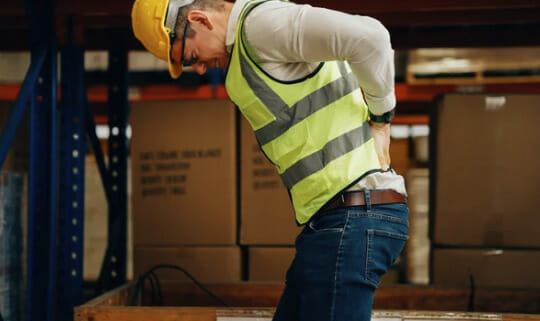Sprains and Strains
New Braunfels, TX, August 9, 2023

Safe + Sound Week is a nationwide event held each August that recognizes the successes of workplace health and safety programs and offers information and ideas on how to keep America’s workers safe. This week, we are taking a moment to focus on Sprains & Strains. According to the Bureau of Labor Statistics (BLS), Musculoskeletal Disorders (MSDs) accounted for 25% of all workplace injuries in construction. Examples of MSDs are carpal tunnel syndrome, tendinitis, and back pain to name a few. Sprains and strains can happen suddenly or develop over the course of days, weeks, or months. When a worker is exposed to risk factors, they are more likely to develop a sprain or strain.
To help understand sprains and strain better, we are going to break it down into three different categories or topic…
First, we are going to identify what sprains and strains are.
Next, we are going to focus on what the common causes are that lead to sprains and strains.
Lastly, we are going to provide some simple steps to help avoid these common injuries.
WHAT ARE SPRAINS AND STRAINS
Athletes in training know their abilities and limitations because going beyond what is
physically possible leads to strained and sprained muscles and ligaments. Those types of injuries can easily put an athlete out of competition. If your job involves lifting and carrying heavy loads from time to time, you should be aware of how much you can do to avoid any injury that could put you on the bench. Sprains and strains can happen anywhere at any time, even at home. A sprain occurs whenever a muscle is stretched beyond its limit. Muscles do a great deal of work. However, they must be conditioned if they are to perform in a certain way. Professional athletes condition their muscles through training programs, we must also condition ourselves for the type of work we do. If you’re having to manually lift things throughout the workday, you need to do that without paying for it with aching muscles.
CAUSES OF SPRAINS AND STRAINS
There are two general categories of risk factors: ergonomic (workplace) risk factors and individual risk factors. Ergonomic risk factors include excessive force like banging or hammering. Excessive repetition like a climber on a 300ft face. Awkward posture places force on joints or muscles when you do not take the time to reposition for a work task. Examples of other environmental factors could be slip, trip, and fall hazards because of the increased risk of a sudden, acute soft tissue injury. Individual risk factors include poor work practices like lifting without a steady footing under you. Poor rest and recovery or poor health habits like dieting or smoking. Unfortunately, there is not a good early warning sign or symptom. Most MSDs develop over the course of time.
SIMPLE STEPS TO HELP AVOID SPRAINS AND STRAINS
What can we do to minimize sprains and strains? Here are a few basic rules to remember: Understand your limitations and don’t charge into a job cold – warm up to it. Take a lesson from athletes by keeping yourself in good condition. Next, don’t overextend yourself – use a stepstool or a ladder when necessary or reposition to a more comfortable seating on the tower. Always lift with your legs and not your back. Keep the load close and don’t twist your body while carrying a load. If in doubt, have someone help. Lastly, be sure there are no slipping or tripping hazards in your work area as the sudden jerk caused by a slip or a trip can cause a sprain or strain.
If you would like more information on this topic or any other safety-related topic, please reach out to the Ontivity safety team at safety@ontivity.com, and we will get you taken care of.
